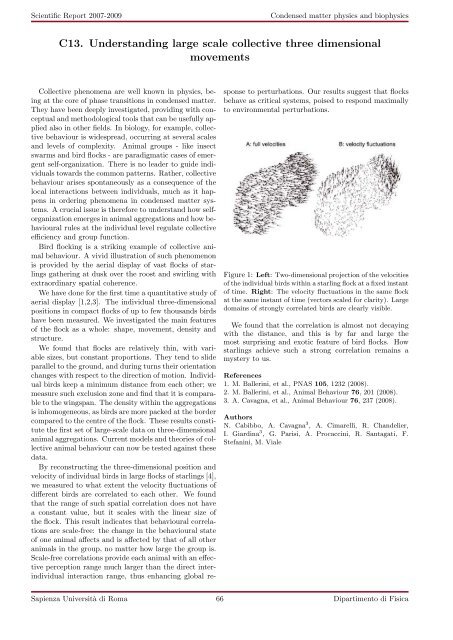download report - Sapienza
download report - Sapienza
download report - Sapienza
Create successful ePaper yourself
Turn your PDF publications into a flip-book with our unique Google optimized e-Paper software.
Scientific Report 2007-2009<br />
Condensed matter physics and biophysics<br />
C13. Understanding large scale collective three dimensional<br />
movements<br />
Collective phenomena are well known in physics, being<br />
at the core of phase transitions in condensed matter.<br />
They have been deeply investigated, providing with conceptual<br />
and methodological tools that can be usefully applied<br />
also in other fields. In biology, for example, collective<br />
behaviour is widespread, occurring at several scales<br />
and levels of complexity. Animal groups - like insect<br />
swarms and bird flocks - are paradigmatic cases of emergent<br />
self-organization. There is no leader to guide individuals<br />
towards the common patterns. Rather, collective<br />
behaviour arises spontaneously as a consequence of the<br />
local interactions between individuals, much as it happens<br />
in ordering phenomena in condensed matter systems.<br />
A crucial issue is therefore to understand how selforganization<br />
emerges in animal aggregations and how behavioural<br />
rules at the individual level regulate collective<br />
efficiency and group function.<br />
Bird flocking is a striking example of collective animal<br />
behaviour. A vivid illustration of such phenomenon<br />
is provided by the aerial display of vast flocks of starlings<br />
gathering at dusk over the roost and swirling with<br />
extraordinary spatial coherence.<br />
We have done for the first time a quantitative study of<br />
aerial display [1,2,3]. The individual three-dimensional<br />
positions in compact flocks of up to few thousands birds<br />
have been measured. We investigated the main features<br />
of the flock as a whole: shape, movement, density and<br />
structure.<br />
We found that flocks are relatively thin, with variable<br />
sizes, but constant proportions. They tend to slide<br />
parallel to the ground, and during turns their orientation<br />
changes with respect to the direction of motion. Individual<br />
birds keep a minimum distance from each other; we<br />
measure such exclusion zone and find that it is comparable<br />
to the wingspan. The density within the aggregations<br />
is inhomogeneous, as birds are more packed at the border<br />
compared to the centre of the flock. These results constitute<br />
the first set of large-scale data on three-dimensional<br />
animal aggregations. Current models and theories of collective<br />
animal behaviour can now be tested against these<br />
data.<br />
By reconstructing the three-dimensional position and<br />
velocity of individual birds in large flocks of starlings [4],<br />
we measured to what extent the velocity fluctuations of<br />
different birds are correlated to each other. We found<br />
that the range of such spatial correlation does not have<br />
a constant value, but it scales with the linear size of<br />
the flock. This result indicates that behavioural correlations<br />
are scale-free: the change in the behavioural state<br />
of one animal affects and is affected by that of all other<br />
animals in the group, no matter how large the group is.<br />
Scale-free correlations provide each animal with an effective<br />
perception range much larger than the direct interindividual<br />
interaction range, thus enhancing global response<br />
to perturbations. Our results suggest that flocks<br />
behave as critical systems, poised to respond maximally<br />
to environmental perturbations.<br />
Figure 1: Left: Two-dimensional projection of the velocities<br />
of the individual birds within a starling flock at a fixed instant<br />
of time. Right: The velocity fluctuations in the same flock<br />
at the same instant of time (vectors scaled for clarity). Large<br />
domains of strongly correlated birds are clearly visible.<br />
We found that the correlation is almost not decaying<br />
with the distance, and this is by far and large the<br />
most surprising and exotic feature of bird flocks. How<br />
starlings achieve such a strong correlation remains a<br />
mystery to us.<br />
References<br />
1. M. Ballerini, et al., PNAS 105, 1232 (2008).<br />
2. M. Ballerini, et al., Animal Behaviour 76, 201 (2008).<br />
3. A. Cavagna, et al., Animal Behaviour 76, 237 (2008).<br />
Authors<br />
N. Cabibbo, A. Cavagna 3 , A. Cimarelli, R. Chandelier,<br />
I. Giardina 3 , G. Parisi, A. Procaccini, R. Santagati, F.<br />
Stefanini, M. Viale<br />
<strong>Sapienza</strong> Università di Roma 66 Dipartimento di Fisica

















